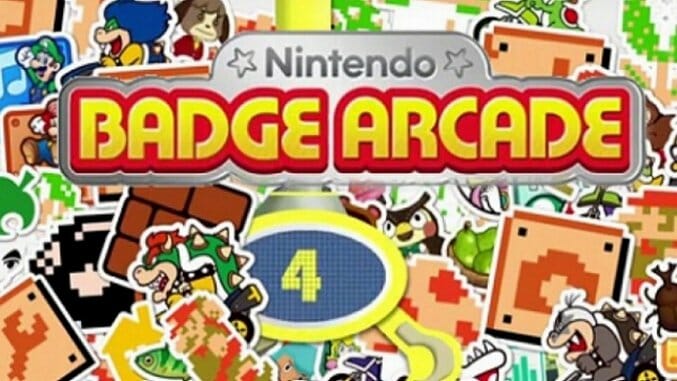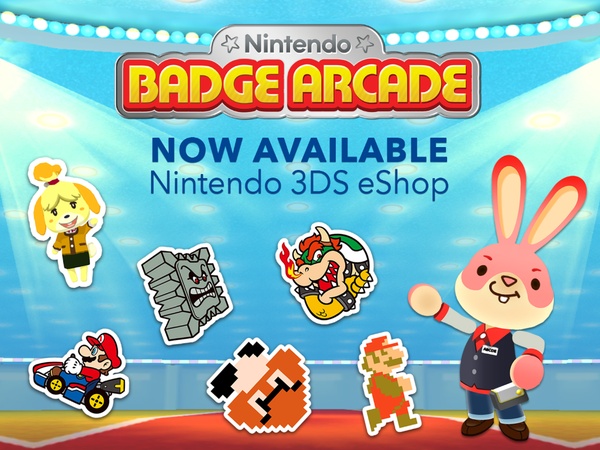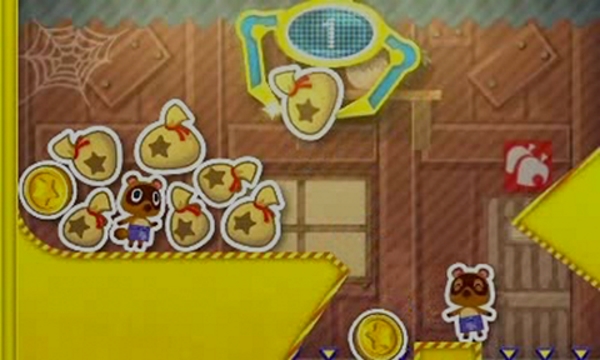Nintendo Badge Arcade: Make It Crane

I’m down to two more plays. I push the big button and the metal claw dollies left. I let go and the claw stops, opens, and drops down toward a pile of prizes. The claw closes, squeezing the sides of a green mushroom, AKA a 1-UP from the Super Mario Bros. games, and begins to lift it up. But the grip does not hold; as the claw returns to its original position, the mushroom slips free and falls back onto the platform. I yell out in agony. One more play remains.
This is Nintendo Badge Arcade, a free-to-start application for the 3DS that became available for download earlier this week. The software has been out in Japan for almost a year, where portable gaming is vastly more popular than in the West. I had heard of this intriguing Badge game and worried we’d never see it brought across the ocean, with Nintendo of America thinking their local customers’ sensibilities too gruff to bother bringing over what sounded like a cute digital toy. But lo, as if a great shining metal claw plucked this from its homeland, swung across the raging waters of the Pacific, and dropped it down below, we Americans (and Europeans) have been graced with this strange, brilliant exercise in playable customization.

The basic activity you’ll be doing here is the digital equivalent to a Crane Game arcade machine, where you manipulate a giant claw down into a vat of stuffed animals and hope that, with your keen sense of depth perception and a bit of the god’s luck, you can walk away with a prize. But the prizes here are “badges”: small graphical icons representing characters or items from Nintendo games. You can then place any badges you win onto the bottom-screen of your 3DS Home Menu, adorning folders or plotting out arrangements as you wish.
Last year, Nintendo began selling “Themes” to customize your Home Menu, comprising a background and special music. Special character-themed themes are $1.99 while simple patterns are $0.99, but all are locked down and unchangeable. Consider a badge the way you might a button on your backpack. Now you can collect and arrange hundreds of these things. And if you have to ask why one might be drawn to such tasks, this software is not for you, sir or madam.
Staying true to its name, Nintendo Badge Arcade runs on a “pay-to-play” basis. A set of five attempts at the machine costs a dollar. Yep: You spend real money to try and win fake badges. Nintendo explains all of this by way of a talking rabbit who walks you through the process. He owns and operates the arcade, you see. And he’s got to keep the lights on. As he explains that you need to pay money to play the game, you’re given a choice to respond with either, “Gotcha” or “Can’t it be free??” Choose the latter and the rabbit widens his eyes, incredulous to the very idea, before responding, “B-but, we’d go out of business!”
This is why a free-to-start customization app has made me forget the last hour of my life: Because even going through the tutorial is a delight. The rabbit gives you five free plays, too, so I have a little something for my effort. You can also earn free plays by playing practice rounds once a day. You don’t need to spend cash to get (or not get) prizes. New stock updates daily and new kinds of badges will be put out to align with upcoming games, giving the curious crane-player further incentive to check back in and try their hand every once in awhile. Then, while you’re there, you just might find yourself dropping a few quid in the slot (visible, waiting, on the bottom-screen, as if your 3DS was a physical arcade unit) to see what happens and also to reward Nintendo’s novel approach to what can be a cynical, regressive money-grab.
“See, we need real income to support this venture,” the rabbit tells you, still explaining why he’s asking for money. And if Nintendo Badge Arcade is anything, it is sound proof (along with last year’s Rusty’s Real Deal Baseball) that Nintendo understands the fragile psychology of this new monetization era we live in, and aims to not simply settle for the same sour tactics as others, but try and establish a new foundation for what a player should expect from these low-cost digital playthings.
Both Rusty and Badge Arcade make the sheer act of paying to play a part of the fun. In Rusty, you bartered with the eponymous dog who just happened to own a baseball game shop; if you’re able to talk him down and give him what he wants (usually a donut), he’ll knock a few bones off the price. In the Arcade, you don’t just choose amongst menu options; you walk from booth to booth, each playing its own style of music. Even the Help Desk, basically an Options Menu, has a festive atmosphere to it.
